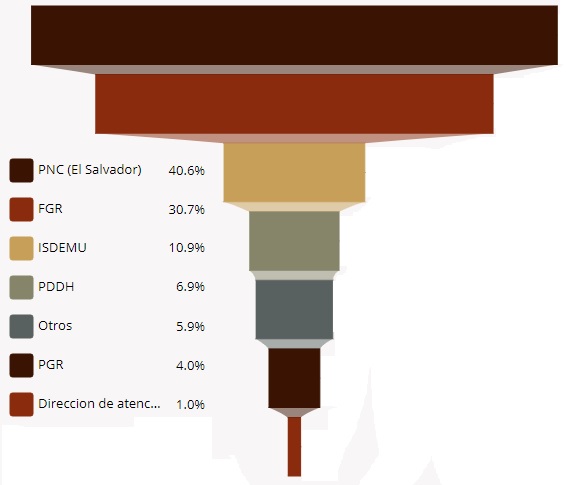Interactive data on displacement in 2018
This content has been created to present the data collected by the Monitoring System in relation to forced displacement due to violence during 2018.
The following data is created as a graph with static data and five dashboards made in tableau. These dashboards are interactive, meaning that if you select any element of the graphs, your selection will act as a filter changing the data shown in that dashboard. Similarly, you can use the side panels where you can select among different options that we have made available. More about Tableau.
You can interact with the data without risk of altering it. If you are confused, you can always clean the filters by reloading the page. Filters and interactions only affect the dashboard in which they are made.

FORCED DISPLACEMENT IN GUATEMALA, HONDURAS, AND EL SALVADOR
Data from January to December 2018
1008 PEOPLE AFFECTED BY VIOLENCE FROM WHICH 251 ARE PEOPLE WHO HAVE FACED DISPLACEMENT
In the year 2018, the Monitoring System identified 373 cases of forced displacement due to violence and a total of 1008 people affected, of which, at the time of the interviews, 251 were displaced (24.9%) and 757 people were potentially facing displacement (75.1%).
Of the total cases, 126 were registered by Cristosal in Honduras, 4 were registered by Cristosal in Guatemala, 166 were registered by Cristosal in El Salvador, 2 were registered by Fundacion Quetzalcoatl, and 241 were registered by EDUCO.
Please note: The data collected referring to January to December 2018 has been updated as new cases from those dates are discovered. The data presented does not reflect a national or investigative sample; instead, this data is what that the monitoring system has been able to collect from participants who were interviewed or assisted by the organizations that are part of the system.
State institutions to which the complainants go.
Of the total number of people interviewed, only 64 filed complaints with State institutions, this is 14.5% of 440 people over 12 years of age. In Guatemala, only 3 out of a total of 22 people filed complaints, while in Honduras, only 28 out of 170 people filed complaints (16.5%).
The graph shows the State institutions that have received complaints from the people interviewed about the crimes that have caused forced displacement due to violence.
Sociodemographic data
The next panel collects all the sociodemographic data, showing information regarding sex, age, and country of origin of the people interviewed in El Salvador, Honduras, and Guatemala.
Please note: each panel is interactive, both within the graphs and within the filter panel on the right side. One of the filters refers to self-confinement, which we interpret as a situation in which people find themselves in the need to stay at home trying to safeguard their life. In addition, the data refer to 920 records of which more detailed information is available.
Data on victims and events
In this panel, the groups of perpetrators are identified by the acts they commit; Within the data collection that is carried out through interviews, three main events are identified and each event is related to a perpetrator. In this dashboard they have been placed in such a way that the events committed by each perpetrator can be identified. You are welcomed to use the available filters as you consider more interesting.
Origin and destination maps
The following panels identifies the place of origin and destination of people displaced due to violence, broken down by department and municipality. The place-of-origin map shows information on the places where the acts of violence that generated the displacement occurred, while the destination map shows the areas where people arrive after facing displacement. You can interact with the maps by department and show the places of origin and destination to visualize the way in which the population moves through the territories.
Please note: Some displaced people are not shown in the destination map because the data could not be obtained or because they have migrated.
Educational and economic impact on victims of violence
The Regional Monitoring System collects information regarding the impact that violence and the resulting forced displacement have on people both at an educational level (studies they are undertaking), as well as at a professional level and the decrease in income resulting from this situation for affected families.
Please note: the graph of income level per family includes data from the total number of interviewed cases (if information was obtained) of people who suffered income losses due to violence, leaving them with essentially zero income.
Intentions when migrating
The System also collects information regarding the number of people who intend to migrate to another country, as well as the intended destination. The investigation found that that 75.5% of 1008 people from whom data was obtained had intentions to migrate.
Please note: In the destination country graph, of the 761 people who mentioned their intention to leave the country, only 490 (47.6%) stated where they were going.

Portal de monitoreo a vulneraciones de derechos humanos
El equipo de investigación de Cristosal brinda monitoreo constante a las violaciones en materia de derechos humanos, para brindar información oportuna y certera sobre las causas y efectos de estas sobre las poblaciones vulneradas. Alimentado por datos provenientes de instituciones Estatales, de sociedad civil y de cooperación internacional, sus publicaciones fortalecen la labor de defensa y promoción de los derechos humanos en el Norte de Centroamérica.

